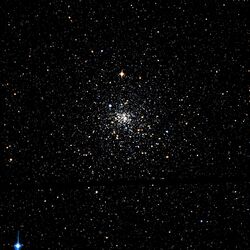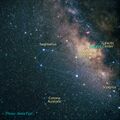Astronomy:NGC 6522
From HandWiki
Short description: Globular cluster in the constellation of Sagittarius
| NGC 6522 | |
|---|---|
 | |
| Observation data (J2000 epoch) | |
| Constellation | Sagittarius |
| Right ascension | 18h 03m 34.1s[1] |
| Declination | −30° 02′ 2.3″[1] |
| Distance | 25.1 kly (7.7 kpc)[2] |
| Apparent magnitude (V) | 8.3[3] |
| Apparent dimensions (V) | 16.4'[3] |
| Physical characteristics | |
| Mass | 3.00×105[2] M☉ |
| Metallicity | [math]\displaystyle{ \begin{smallmatrix}\left[\ce{Fe}/\ce{H}\right]\end{smallmatrix} }[/math] = –1.34[2] dex |
| Estimated age | 12.0 Gyr[4] |
| Other designations | GCl 82, C 1800-300[1] |
NGC 6522 is a globular cluster in the constellation Sagittarius. It is apparent magnitude 8.3, and diameter 16.4 arc minutes, and class VI with stars 16th magnitude and dimmer. It was discovered by William Herschel on June 24, 1784. It is centered in a region of the sky known as Baade's Window.[1][3]
NGC 6522 is possibly the oldest star cluster in the Milky Way,[5] with an age of more than 12 billion years.[6]
Gallery
The globular clusters NGC 6528 (lower left) is close to NGC 6522 (upper right)
The cluster is located in Baade's Window, a region of night sky that is not clouded by dust from the Milky Way.
References
- ↑ 1.0 1.1 1.2 1.3 "SIMBAD Astronomical Database". Results for NGC 6522. http://simbad.u-strasbg.fr/simbad/sim-basic?Ident=NGC+6522.
- ↑ 2.0 2.1 2.2 Boyles, J. et al. (November 2011), "Young Radio Pulsars in Galactic Globular Clusters", The Astrophysical Journal 742 (1): 51, doi:10.1088/0004-637X/742/1/51, Bibcode: 2011ApJ...742...51B.
- ↑ 3.0 3.1 3.2 "NGC 6522". http://spider.seds.org/spider/MWGC/n6522.html.
- ↑ Koleva, M. et al. (April 2008), "Spectroscopic ages and metallicities of stellar populations: validation of full spectrum fitting", Monthly Notices of the Royal Astronomical Society 385 (4): 1998–2010, doi:10.1111/j.1365-2966.2008.12908.x, Bibcode: 2008MNRAS.385.1998K
- ↑ "VLT-FLAMES Analysis of 8 giants in the Bulge Metal-poor Globular Cluster NGC 6522: Oldest Cluster in the Galaxy?" by B. Barbuy et al., 2009
- ↑ "The universe's first stars were whirling dervishes", New Scientist by David Shiga, 30 April 2011, p. 20. "Imprints of fast-rotating massive stars in the Galactic Bulge" by Cristina Chiappini et al., Nature 472, pp. 454–457 (28 April 2011).
External links
 |



